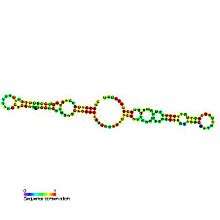Small nucleolar RNA SNORA35
| Small nucleolar RNA SNORA35 | |
|---|---|
 Predicted secondary structure and sequence conservation of SNORA35 | |
| Identifiers | |
| Symbol | SNORA35 |
| Alt. Symbols | snoHBI-36 |
| Rfam | RF00566 |
| Other data | |
| RNA type | Gene; snRNA; snoRNA; HACA-box |
| Domain(s) | Eukaryota |
| GO | 0006396 0005730 |
| SO | 0000594 |
Homo sapiens snoRA35 (also known as HBI-36) is an H/ACA box snoRNA, first cloned from a mouse adult brain cDNA library by Cavaillé et al. (2000),[1] and found to be specifically expressed in the choroid plexus. Its human orthologue, HBI-36 was discovered by a homology search, and was found to be specifically expressed in the brain. Its gene resides in the second intron of the serotonin receptor 2c (5HT-2c) gene, which is predominantly expressed in choroid plexus epithelial cells. The human 5HT-2c mRNA was predicted to be 2'O-methylated by the C/D box snoRNP HBII-52 at a position also subjected to A:I editing. HBI-36 has no documented RNA target.
References
- ↑ Cavaille, J; Buiting K; Kiefmann M; Lalande M; Brannan CI; Horsthemke B; Bachellerie JP; Brosius J; Huttenhofer A (2000). "Identification of brain-specific and imprinted small nucleolar RNA genes exhibiting an unusual genomic organization". Proc Natl Acad Sci U S A. 97 (26): 14311–14316. doi:10.1073/pnas.250426397. PMC 18915
 . PMID 11106375.
. PMID 11106375.
External links
This article is issued from Wikipedia - version of the 1/3/2015. The text is available under the Creative Commons Attribution/Share Alike but additional terms may apply for the media files.